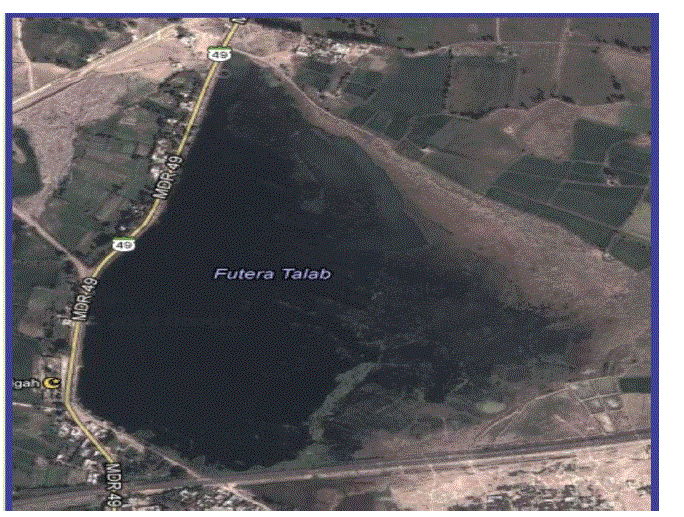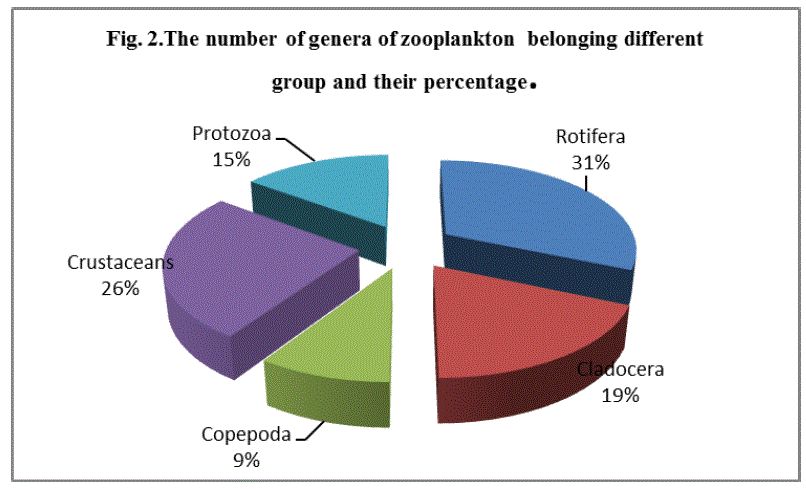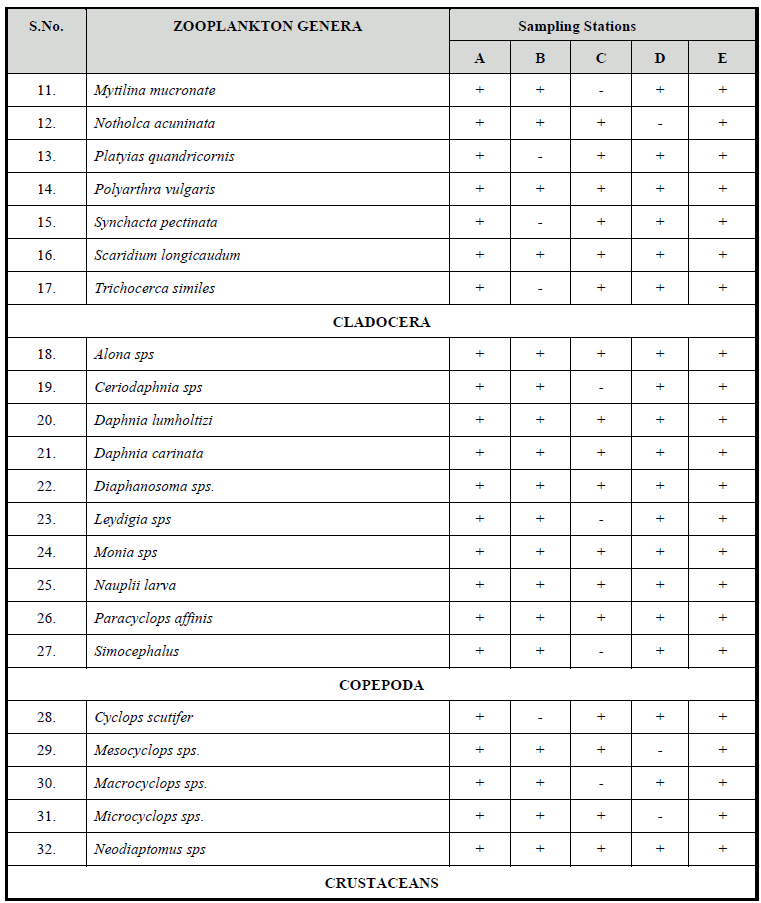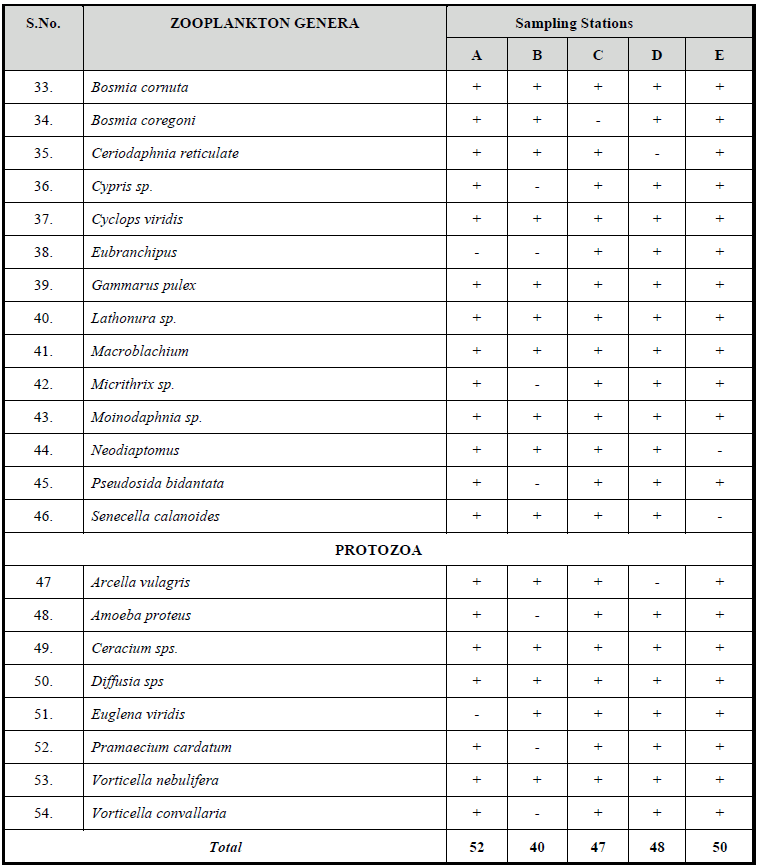ISSN ONLINE(2319-8753)PRINT(2347-6710)
ISSN ONLINE(2319-8753)PRINT(2347-6710)
| Hemlata Verma1 , Dr. Devendra N. Pandey2 and Dr. Sandeep K. Shukla3 |
| Related article at Pubmed, Scholar Google |
Visit for more related articles at International Journal of Innovative Research in Science, Engineering and Technology
The zooplanktons were represented by the Crustace, Rotifers and Protozoa. The Crustaceans were the most dominating group, followed by Rotifers and then protozoa. Zooplanktons are the smallest, acellular or metazoans in water bodies, ranging in size from about 0.05 to 10 mm. Protozoans, Rotifers, Crustaceans (i.e. Cladocera; Rotifers and ostracoda) and small insects constitution most zooplankton communities. They provide food for many species of fish and are therefore, vital in the food web of ponds; dams are rivers. They are also used as an index of productivity, eutrophication and pollution of the water bodies. Monthly variation in the number of zooplankton with the communities occupying higher trophic levels, were recorded in Futera pond, Damoh, M.P. The zooplankton population of Futera pond was studied for a period of 12 months from June 2011- May 2012.The zooplanktons were represented by five groups of organisms in order Rotifera>Crustacean > Cladocera > Protozoa > Copepoda. The zooplankton were composed of Rotifera (31.48%), Cladocera (18.52%), Copepoda (9.26%), Crustaceans (25.92%) and Protozoa (14.82%). A Total number of 54 genera were observed during the present study. The highest qualitative value of total zooplankton recorded in Futera pond was 944.8±32.05 org/l in the month of August, while the lowest value of total zooplankton was recorded 448.4±10.01 org/l in the month of January. The fluctuation in the number of zooplankton was discussed in relation to the physico-chemical and other environmental condition of the pond. Dominance of Rotifers and Crustaceans indicate the eutrophic status of pond.
Keywords |
| Futera pond, Zooplankton, Rotifers, Crustacean, Copepoda, Protozoa. |
INTRODUCTION |
| Zooplanktons are microscopic free swimming heterogeneous assemblage of minute floating animal forms found in aquatic systems, are represented by wide array of taxonomic groups (Protozoa, Rotifera, Cladocera, Crustacea and Copepoda). These are most common and often dominate the entire consumer communities. They are endowed with many remarkable features and are often armoured with pines, which hamper their predation by higher organisms. The zooplankton which play a role of converting phytoplankton into food, suitable for fish and aquatic animals have acquired importance in fishery research. The zooplanktons can also play an important role in indicating the presence or absence of certain species of fishes on in determining the population densities. Zooplankton plays major role in the food web of an aquatic ecosystem and forms an intermediate link between primary and tertiary production. Study of plankton diversity and their ecology greatly contribute to an understanding of the basic nature and general economy of an aquatic habitat. Zooplanktons are capable of concentrating large quantities of heavy metals from water bodies. These metals may be passed on and concentrated at higher trophic levels through the food chain. Thus it is necessary to understand whether the mortality is due to biomagnifications of heavy metals or pollutants. The fishery potential is fully related to the presence of zooplankton ( Dubey et.al 2006). Nutrients mainly nitrogen and phosphorus act as bio-stimulants causing eutrophication or enhancement of the growth of zooplankton and phytoplankton. This can lead to luxuriant growth of unusual plankton blooms, that may or may not be toxic, but which on decay use up oxygen from the water which also cause deoxygenation. Phytoplanktons are representing the microscopic algal communities at primary level, whereas zooplankton at secondary level. They react quickly to limnological change of aquatic environment. They can be listed and used as pollution indicators (Telkhade et.al. 2008). Uncontrolled domestic wastewater discharge into the pond has resulted in the eutrophication of the pond as evidenced by substantial algal blooms, dissolved oxygen depletion in the subsurface waters, large fish kill and malodour generation. These conditions continued unabated and give rise to monoculture of water hyacinth (Eichhornia crassipes) which covered almost the entire pond area. |
| The present investigation has been undertaken to assess the monthly variations in the occurrence of zooplanktons of Futera pond, Damoh district (M.P.) during June, 2011 to May’ 2012, whose banks have been developed into an attractive tourist spot of the city. |
STUDY AREA |
| The present study has been carried out on Futera pond of Damoh district in Madhya Pradesh. The topographical situation of Futera pond is 23°5' N longitude and 79°26' E latitude in central India and situated in Futera ward No.5 besides the railway line from Bina to Katni in Damoh district. The area of Futera pond is about 36.923 hectares and depth is 4.50 meter. The depth of pond is variable from season to season. The water storage capacity of Futera pond is about 48 MCFT(Fig. No. 1). The pond is anthropogenic and pond water is used for domestic purpose, irrigation, aquaculture etc. The surrounding area of pond is semi urban and semi agricultural. The need to define quality of water has development with the increasing demand of water, which is suitable for specific uses and confirms to desired quality. |
 |
MATERIAL AND METHODS |
| Samples were collected monthly from Five different sampling stations namely A, B, C, D, and E for one year (June 2011 to May 2012). The samples were collected at 11 am -1pm during second week of each month. Under qualitative analysis of planktonic communities the identification was done; as for as possible to species level. Sample was collected for planktonic population net in each month. Microphotography, camera Lucida diagrams etc. were the main tools for this taxonomy study of the planktonic species. For the quantitative studies of plankton twenty liter water was filtered through a piece of silk bolting cloth from each station and the collection samples were preserved in 4% formalin. Plankton counting was done with the help of Sedgwick Rafter cell. The average number of planktonic forms per liter was calculated by the following formula:- |
 |
| Where, C = Number of planktonic organisms counted in all strips |
| L= Length of strip |
| D= Depth of a strip |
| W= Width of a strip |
| S= Numbers of strips counted |
RESULTS AND DISCUSSION |
| Zooplankton: |
| A total of 54 genera of zooplanktons have been identified during the research period and are listed in table no. 1. (Fig. no. 2). The values of total number of zooplankton have been noted to varied with an increasing trend from January up to August and becoming maximum in the month of August due to rain brings more zooplankton from the water bodies of upper reaches to the sites under investigation. Then a decline is recorded from September onwards up to December. Zooplankton mainly belong to the groups of Rotifera, Cladocera, Copepoda, Crustaceans, and Protozoa. Zooplanktons are considered to be the ecological indicators of water bodies (Gajbhiye and Desai 1981). Factors such as light intensity, food availability, dissolved oxygen and predation effect the population dynamics of zooplankton. Low pH or higher salinity can reduce their diversity and density (Horn and Goldman, 1994). The samples from five sampling sites have been analyzed for spatial and temporal distribution. It shows the presence of 54 species, out of which 17 species belong to rotifera, 10 species are of cladocera 5 species are of copepod, crustacean 14 and 8 species protozoa. The zooplankton assemblage of this pond consists primarily of rotifera followed by cladocerans, copepods, crustaceans and protozoa. Seasonal variation of the zooplankton populations of Futera pond correlate to changes in environmental factors. Ghosh (1997) observed that among total zooplanktonic population, cladocera come second in order of abundance in Husan Sagar reservoir. Zooplankton community dynamics is also altered with environmental degradation. Presence of higher density of copepod and harpacticoid indicates their tolerance of higher salinity of water. Among Zooplanktons, the member of Protozoa, Rotifers, Copepoda Cladoceran and Crustaceans were present in all months. Among these the Rotifers were the most abundant throughout the study period. The present investigation also supports the findings of Sharma and Capoor (2010). Dominance of protozoan and rotiferan communities indicates water quality deterioration and onset of eutrophication at alarming rate (Sharma et al, 2010). |
 |
| Zooplankton density (Org./l): |
| The highest qualitative value of total zooplankton recorded in Futera pond was 944.8±32.05 org/l in the month of August, while the lowest value of total zooplankton was recorded 448.4±10.01 org/l in the month of January. The zooplankton species identified in this study were composed of Rotifera (31.48%), Cladocera (18.52%), Copepoda (9.26%), Crustaceans (25.92%) and Protozoa (14.82%). A Total number of 54 genera were observed during the present study (fig.2). |
| Pahwa and Mehrotra (1966) reported rotifer population from Ganga river, where they constituted 61.5 to 94.4% of population. Govind (1969) reported a rotifer peak in February (24.7%) out of the total zooplankton from shallow zone of Tungbhadra reservoir. Gupta (1989) reported a major rotifer peak in August and in February from two ponds near Jodhpur. Sheeba et. al. (2004) Qualitative and quantitative study of zooplankton in Ithikkara river, Kerala. These exhibited a bimodal pattern with a major peak in December and a minor peak in August. The second group of zooplankton, Copepoda, also exhibited two maxima (April & August) and two minima (February, March and September). |
CONCLUSION |
| Therefore it can be concluded through this study that the age old Futera pond with social and cultural importance is degrading at an alarming rate and eutrophic status. In the past two decades the pond has shown drastic changes regarding the productivity. The rapid increase of human activities and assemblage of livestock are creating pollution in the pond water and needs immediate measure. At this critical juncture the local representatives, Government and Non- Government bodies, the educated bodies, the village heads and the reputed figures of the society should come forward and formulate conservational model for the sustainability of this beautiful water body. |
 |
 |
 |
References |
|